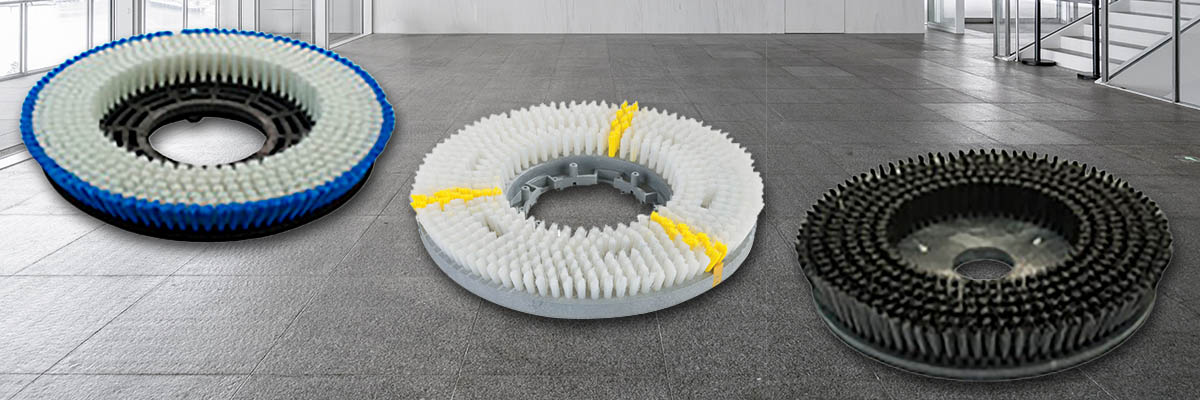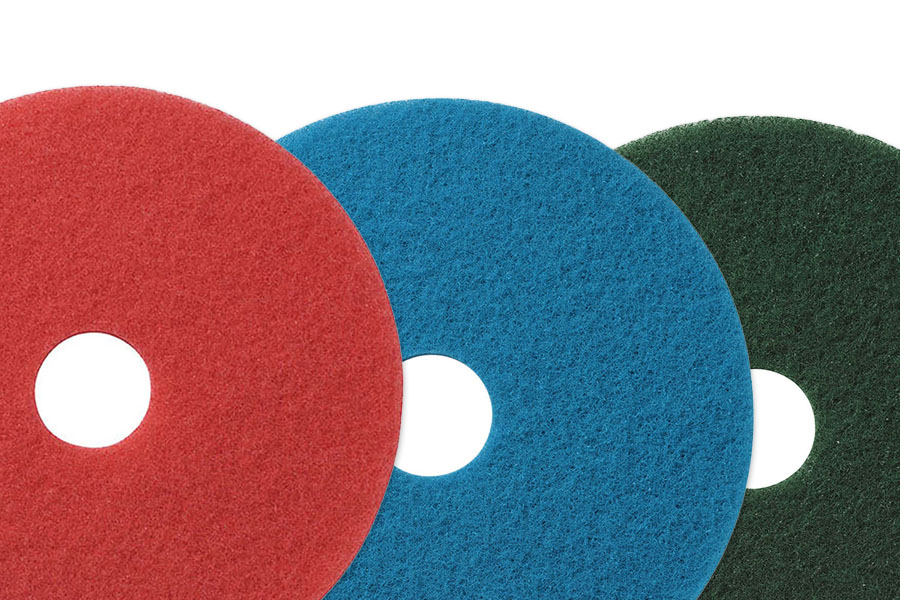Floor Pads vs Brushes: Which is best for your cleaning program?
Every janitorial professional knows the secret to impeccable floors lies in their tools. When it comes to achieving a clean, pristine floor, the choice between floor pads and brushes is critical.

Brushes come in several materials and stiffness levels, while pads offer diverse textures and densities for different cleaning tasks. Knowing which to choose can significantly impact the effectiveness of your cleaning program. This article will help you understand your choices, considering each's advantages and shortcomings.
Understanding the types of floor scrubber brushes and pads
Floor scrubber brushes are available in a wide variety, each type designed for a certain type of flooring and soil. For instance, softer brushes like nylon are suitable for delicate floors that can be easily scratched. In contrast, polypropylene brushes are more versatile, catering to light to medium-duty cleaning across different types of flooring. Specifications for brushes will commonly include a measure of the thickness of the brush filaments and the grit value of the abrasive on the bristles, if any.
Floor scrubber pads are categorized by color, indicating their abrasiveness level. This system simplifies choosing the correct pad for tasks ranging from polishing to stripping floor finish.
Overall, selecting the right brush or pad for your floor machine involves assessing the floor surface and the kind of soil being addressed.
Different types of floor scrubber brushes
A heavier-duty brush may be needed for floors with more stubborn soil or debris. In these situations, brushes embedded with abrasive grit come into play. Grit brushes are particularly effective on surfaces with heavy buildup, making them ideal for concrete floors or industrial environments with heavy foot traffic.
Different types of floor scrubber pads
Floor scrubber pads are selected based on the level of cleaning aggressiveness required. In general, the color-coding system aids in identifying the right pad for the job:
White Polishing Pads: Least aggressive; designed for high gloss shine and polishing.
Red Pads: Light scrubbing and some polishing tasks.
Blue Pads: Mid-range in terms of abrasiveness; used for everyday cleaning applications.
Green Pads: Upper-range in terms of abrasiveness; used for heavy-duty scrubbing or deep scrubbing and top coating of acrylic polish.
Brown, and Black Pads: The most aggressive; employed for stripping old floor finish and heavy-duty cleaning tasks.
For a complete guide for floor pad selection, see this article. Proper Floor Pad Selection: It's in the colors
Pros and cons of scrubbing brushes
Brushes are known for their durability, especially on rough surfaces like concrete, making them a long-term investment that supports environmental sustainability by reducing the need for frequent replacements. They are versatile, adept at cleaning smooth surfaces, reaching grout on tiled floors, and tackling stubborn dirt on rough cement. The variety of brushes, such as nylon for gentle scrubbing, ensures effective cleaning for different floor types. While high-quality floor scrubber brushes have higher upfront costs compared to pads, their prolonged lifespan often makes them more cost-effective over time. This longevity spreads maintenance costs and reduces packaging, storage, and waste.
Pros of Scrubbing Brushes:
- Long-lasting on uneven and rough surfaces
- Environmental sustainability through reduced waste
- Versatile for a range of surfaces, including textured floors
- Variety of brush types for specific floor scrubber needs
Cons of Scrubbing Brushes:
- Higher initial cost compared to floor pads
- May require different types of brushes for different floor surfaces

Pros and cons of scrubbing pads
When considering tools for floor scrubbers, scrubbing pads are a popular choice for a wide variety of floor surfaces.
Pros of Scrubbing Pads:
Versatility: There is a broad selection of pad colors, each designed for specific cleaning tasks ranging from gentle buffing to aggressive stripping. This makes them suitable for various types of smooth flooring such as terrazzo floors and Vinyl Composition Tile (VCT).
Cost-Effective: Initially, scrubbing pads are more budget-friendly compared to floor scrubber brushes. They can be an economical option for facilities with a tight maintenance budget.
Cons of Scrubbing Pads:
Durability: Compared to brushes, pads have a shorter lifespan. They can quickly wear out or get torn when used on uneven or rough surfaces.
Surface Suitability: While they are versatile, scrubbing pads may not be the best choice for highly textured floors or for cleaning deep grout lines where a specific type of brush might be more effective.
Specific applications for scrubbing brushes and pads
Best brushes for cleaning vinyl flooring
For maintaining vinyl floors, it is generally best to employ soft materials to prevent scratching. Nylon scrubbing brushes, recognized for their soft bristles, are exceptionally versatile and suitable for cleaning these floor types without causing damage. Polypropylene brushes, commonly equipped as standard on floor scrubbers, can clean small crevices effectively.
Best brushes for cleaning concrete floors
Choose stiffer brushes when dealing with concrete floors, particularly in venues like warehouses or shop floors that experience heavy foot traffic and machinery movement. While polypropylene brushes offer a good degree of scrubbing power for concrete, more aggressive cleaning tasks may call for gritted brushes impregnated with silicon carbide. For polished or epoxy-coated concrete, it's advisable to use softer brush types or pad drivers to avoid scratching the smooth surface.
Best brushes for cleaning ceramic and porcelain tiles
Medium brushes are the go-to for cleaning glazed ceramic and porcelain tiles as they effectively scrub grout lines without damaging the finish. For matte or lightly textured tiles, pads often suffice, affording a superior clean.
Best brushes for cleaning epoxy non-slip floors
Epoxy non-slip floors benefit from the use of brushes that are effective yet gentle enough not to degrade the non-slip properties. Soft or medium brushes work best, depending on the required cleaning aggressiveness. Using a brush that is too hard could diminish the non-slip texture over time and should be avoided.
Best brushes for cleaning rubber floors
Rubber floors, often found in gyms and play areas, need cleaning processes that can handle the material's elasticity without causing damage. Nylon brushes, known for their soft texture, are apt for this task. Brushes have the advantage of longevity over pads, which translates to cost effectiveness and better suitability for textured or uneven rubber floors.
IMPORTANT! Be cautious when trying out new brushes or pads
When testing a new scrub brush or scrub pad on a floor scrubber, it's essential to exercise caution to prevent damage to both the machine and the flooring. Start by conducting a small, inconspicuous test area to ensure the brush or pad is compatible with the floor material. Different brushes and pads have varying levels of abrasiveness, which can impact the surface finish. Using the wrong type can lead to scratches, scuffs, or even more severe damage. Additionally, ensure the scrubber's settings, such as pressure and speed, are appropriately adjusted for the new accessory. Monitoring the initial usage closely allows for immediate adjustments, ensuring optimal cleaning performance without compromising the integrity of the flooring.
Let Hillyard's Experts Guide The Way
Hillyard is proud to have cleaning experts located throughout the United States, ready to assist you in selecting the perfect brush or pad for your specific cleaning needs. Our knowledgeable representatives are equipped with the expertise to guide you through the process, ensuring you choose the most effective tools for your floor maintenance. To take advantage of our personalized assistance, simply fill out the "I'm interested" form at the bottom of the page, and one of our dedicated representatives will contact you shortly to provide tailored recommendations and support.